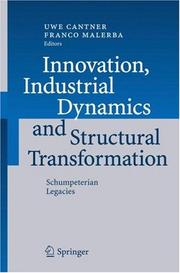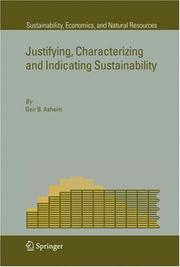| Listing 1 - 5 of 5 |
Sort by
|

ISBN: 128080534X 9786610805341 3540494650 3540494642 3642080480 Year: 2007 Publisher: Berlin, Heidelberg : Springer-Verlag Berlin Heidelberg,
Abstract | Keywords | Export | Availability | Bookmark
 Loading...
Loading...Choose an application
- Reference Manager
- EndNote
- RefWorks (Direct export to RefWorks)
This book provides an account of work in the Schumpeterian and evolutionary tradition of industrial dynamics and the evolution of industries. It is shown that over time industries evolve and change their structure. In this dynamic process change is affected and sometimes constraint by many factors: knowledge and technologies, the capabilities and incentives of actors, new products and processes, and institutions. All these elements and their relations drive innovative activities and affect economic performance in an industry. Investigations into these complex phenomena show a deep interdependence between empirical work delivering a rich account of regularities and stylized facts in the structure of industries and their change, and theoretical analyses ranging from appreciate theorizing to formal modeling. .
Economics. --- Endogenous growth (Economics) --- Economic development --- Economic theory --- Political economy --- Social sciences --- Economic man --- Economic policy. --- Economic growth. --- R & D/Technology Policy. --- Economic Growth. --- Development, Economic --- Economic growth --- Growth, Economic --- Economic policy --- Economics --- Statics and dynamics (Social sciences) --- Development economics --- Resource curse --- Economic nationalism --- Economic planning --- National planning --- State planning --- Planning --- National security --- Social policy

ISSN: 16153871 ISBN: 1281065781 9786611065782 354072110X 3540721096 364209127X Year: 2007 Publisher: Berlin ; New York : Springer,
Abstract | Keywords | Export | Availability | Bookmark
 Loading...
Loading...Choose an application
- Reference Manager
- EndNote
- RefWorks (Direct export to RefWorks)
The development of a bio-engineered pacemaker is of substantial clinical and also scientific interest because it promises to overcome several limitations of electronic pacemakers. Moreover it may answer the longstanding question of whether the complex structure of the sinus node is indeed a prerequisite for reliable pacemaking, or simpler structures might work as well. This book gives an overview of the current state-of-the-art of creating a bio-engineered pacemaker. It shows the approaches to develop of genetic and cell-based engineering methods suitable to implement them with safety and stability. It also illuminates the problems that need to be solved before bio-pacemaking can be considered for clinical use.
Biological rhythms. --- Pacemaker cells. --- Mathematical Sciences --- Applied Mathematics --- Engineering. --- Human physiology. --- Cardiology. --- Application software. --- Biophysics. --- Biological physics. --- Biomedical engineering. --- Biomedical Engineering. --- Human Physiology. --- Computer Applications. --- Biophysics and Biological Physics. --- Clinical engineering --- Medical engineering --- Bioengineering --- Biophysics --- Engineering --- Medicine --- Biological physics --- Biology --- Medical sciences --- Physics --- Application computer programs --- Application computer software --- Applications software --- Apps (Computer software) --- Computer software --- Heart --- Internal medicine --- Human biology --- Physiology --- Human body --- Construction --- Industrial arts --- Technology --- Diseases --- Biological pacemakers --- Natural pacemakers --- Pacemakers, Biological --- Cells --- Biological rhythms --- Biological clocks --- Biorhythms --- Endogenous rhythms --- Living clocks --- Rhythms, Biological --- Chronobiology --- Cycles --- Pacemaker cells --- Periodicity --- Computer science. --- Biomedical Engineering and Bioengineering. --- Biological and Medical Physics, Biophysics. --- Informatics --- Science
Multi
ISSN: 18746691 ISBN: 9789004381506 Year: 2007 Volume: 17 Publisher: Leiden [etc.] Brill
Abstract | Keywords | Export | Availability | Bookmark
 Loading...
Loading...Choose an application
- Reference Manager
- EndNote
- RefWorks (Direct export to RefWorks)
"Conspiracy theories are a ubiquitous feature of our times. The Handbook of Conspiracy Theories and Contemporary Religion is the first reference work to offer a comprehensive, transnational overview of this phenomenon along with in-depth discussions of how conspiracy theories relate to religion(s). Bringing together experts from a wide range of disciplines, from psychology and philosophy to political science and the history of religions, the book sets the standard for the interdisciplinary study of religion and conspiracy theories"--
Cults. --- Conspiracy theories. --- Cults --- Conspiracy theories --- conspiracy theories --- conspiracy theory --- conspiracism --- conspiracy belief --- conspiracy thinking --- conspiracies --- disinformation --- psychology of conspiracy theories --- Japan --- Japanese new religious movements --- Aum Shinrikyo (オウム真理教) --- sarin --- terrorism --- religion and conspiracy theories --- Japanese conspiracy culture --- anti-semitism --- Internet and conspiracy theories --- satanism --- cults and conspiracies --- South Africa --- popular music --- exogenous conspiracy theories --- religion and music --- endogenous conspiracy theories --- popular culture --- Esotericism and conspiracy theories --- Millennial conspiracism --- Sri Lanka --- Buddhism --- Buddhist islamophobia --- islamism --- Albania --- Albanian mythology --- Greece --- ufology --- apocalypticism --- Post-Soviet Russia --- neo-nazism --- cults --- sects --- new religious movements (NRM) --- Falun Gong (法輪功) --- consumerism --- new relgions --- Church of the SubGenius (COSG) --- parody religions --- conspirituality

ISBN: 9781402062001 1402061994 9781402061998 9048175631 9786613934185 1402062001 1283621738 Year: 2007 Publisher: Dordrecht : Springer,
Abstract | Keywords | Export | Availability | Bookmark
 Loading...
Loading...Choose an application
- Reference Manager
- EndNote
- RefWorks (Direct export to RefWorks)
In 1987 the report of the World Commission on Environment and Development (WCED) introduced the concept of sustainable development into the political agenda. The notion of sustainability and the need to understand its full implications have sparked much interest and considerable research in various disciplines, including economics. This volume brings together 18 articles published during the last 20 years, devoted to understanding the concept of sustainable development. These articles provide economic analysis of this notion from three different perspectives: Justifying Sustainability (why care about whether development is sustainable) Characterizing Sustainability (what does sustainable development look like) Indicating Sustainability (how to tell whether development is sustainable) The first part (Justifying Sustainability) analyzes from a normative point of view why it is desirable for our generation to contribute to the implementation of sustainable development. The second part (Characterizing Sustainability) describes how manmade capital (both real and human) must be accumulated in order to make up for decreased availability of natural capital. The third part (Indicating Sustainability) examines rules and methods for attaining sustainable development for current and future generations. Each part begins with an article which functions as a survey. An up to date introduction serves to tie the three parts of the volume together.
Environment. --- Sustainable Development. --- Environmental Economics. --- Economic Growth. --- Environment, general. --- Environmental sciences. --- Sustainable development. --- Endogenous growth (Economics). --- Environmental economics. --- Sciences de l'environnement --- Développement durable --- Croissance endogène (Economie politique) --- Economie de l'environnement --- Economic development -- Environmental aspects. --- Sustainable development -- Mathematical models. --- Earth & Environmental Sciences --- Environmental Sciences --- Sustainability. --- Sustainability science --- Economic growth. --- Human ecology --- Social ecology --- Environmental science --- Science --- Development, Economic --- Economic growth --- Growth, Economic --- Economic policy --- Economics --- Statics and dynamics (Social sciences) --- Development economics --- Resource curse --- Environmental quality --- Development, Sustainable --- Ecologically sustainable development --- Economic development, Sustainable --- Economic sustainability --- ESD (Ecologically sustainable development) --- Smart growth --- Sustainable development --- Sustainable economic development --- Economic development --- Environmental aspects --- Economic aspects --- Balance of nature --- Biology --- Bionomics --- Ecological processes --- Ecological science --- Ecological sciences --- Environment --- Environmental biology --- Oecology --- Environmental sciences --- Population biology --- Ecology
Book
ISBN: 9781402067020 1402067011 9781402067013 9048177014 9786612823565 140206702X 1282823566 Year: 2007 Publisher: Dordrecht, The Netherlands : Springer,
Abstract | Keywords | Export | Availability | Bookmark
 Loading...
Loading...Choose an application
- Reference Manager
- EndNote
- RefWorks (Direct export to RefWorks)
This book has been several years in the making. It has grown out of basic areas of inquiry begun under the auspices of the Alliance for Global Sustainability in the late 1990s, and has culminated with a series of on-site, collaborative studies conducted through AGS in cooperation with of?cials in Guangzhou, People’s Republic of China (PRC), during the early 2000s. Many individuals have made important contributions to the ideas, ?ndings, and results that have been compiled in this volume. The authors wish to recognize these signi?cant contributions below. The Alliance for Global Sustainability is an international partnership among four of the leading scienti?c and technological universities worldwide: • The Massachusetts Institute of Technology (MIT-AGS); • The University of Tokyo (UT); • The Swiss Federal Institute of Technology (ETH); and • The Chalmers University of Technology. Created in 1997, the AGS today brings together hundreds of university scientists, engineers, and social scientists to address complex issues that lie at the intersection of environmental, economic, and social policy goals. Since its inception, the AGS has promoted and supported multidisciplinary research teams drawn from its partner institutions. Working on critical issues in sustainability across several ?elds encompassing energy and climate, mobility, urban systems, water and agriculture, cleaner technologies, public policy, and communications, these teams have developed a signi?cant body of new knowledge. Furthermore, A- sponsored teamshave worked withengaged,farsighted leaders of global businesses and industries, governments, and non-governmental organizations (NGOs) to provide innovative but practical solutions to urgent environmental problems worldwide.
Environment. --- Environmental Management. --- Atmospheric Protection/Air Quality Control/Air Pollution. --- Climate Change. --- Economic Growth. --- Public Finance & Economics. --- Environmental sciences. --- Climatic changes. --- Environmental management. --- Environmental protection. --- Endogenous growth (Economics). --- Finance. --- Sciences de l'environnement --- Climat --- Environnement --- Croissance endogène (Economie politique) --- Finances --- Changements --- Gestion --- Protection --- Metropolitan areas. --- Sustainable development. --- Urban transportation -- Environmental aspects. --- Earth & Environmental Sciences --- Environmental Sciences --- Urban transportation --- Environmental aspects. --- City transportation --- Metropolitan transportation --- Municipal transportation --- Transportation, Urban --- Development, Sustainable --- Ecologically sustainable development --- Economic development, Sustainable --- Economic sustainability --- ESD (Ecologically sustainable development) --- Smart growth --- Sustainable development --- Sustainable economic development --- Conurbations --- MAs (Metropolitan areas) --- Metropolitan statistical areas --- Urban areas --- Environmental aspects --- Climate change. --- Air pollution. --- Public finance. --- Economic growth. --- Public Economics. --- City planning --- Transportation --- Urban policy --- Economic development --- Development, Economic --- Economic growth --- Growth, Economic --- Economic policy --- Economics --- Statics and dynamics (Social sciences) --- Development economics --- Resource curse --- Changes, Climatic --- Changes in climate --- Climate change --- Climate change science --- Climate changes --- Climate variations --- Climatic change --- Climatic changes --- Climatic fluctuations --- Climatic variations --- Global climate changes --- Global climatic changes --- Climatology --- Climate change mitigation --- Teleconnections (Climatology) --- Cameralistics --- Public finance --- Currency question --- Environmental quality management --- Protection of environment --- Environmental sciences --- Applied ecology --- Environmental engineering --- Environmental policy --- Environmental quality --- Environmental stewardship --- Stewardship, Environmental --- Management --- Public finances --- Air --- Air contaminants --- Air pollutants --- Air pollution --- Air pollution control --- Air toxics --- Airborne pollutants --- Atmosphere --- Contaminants, Air --- Control of air pollution --- Pollutants, Air --- Toxics, Air --- Pollution --- Air quality --- Atmospheric deposition --- Control --- Global environmental change
| Listing 1 - 5 of 5 |
Sort by
|

 Search
Search Feedback
Feedback About UniCat
About UniCat  Help
Help News
News